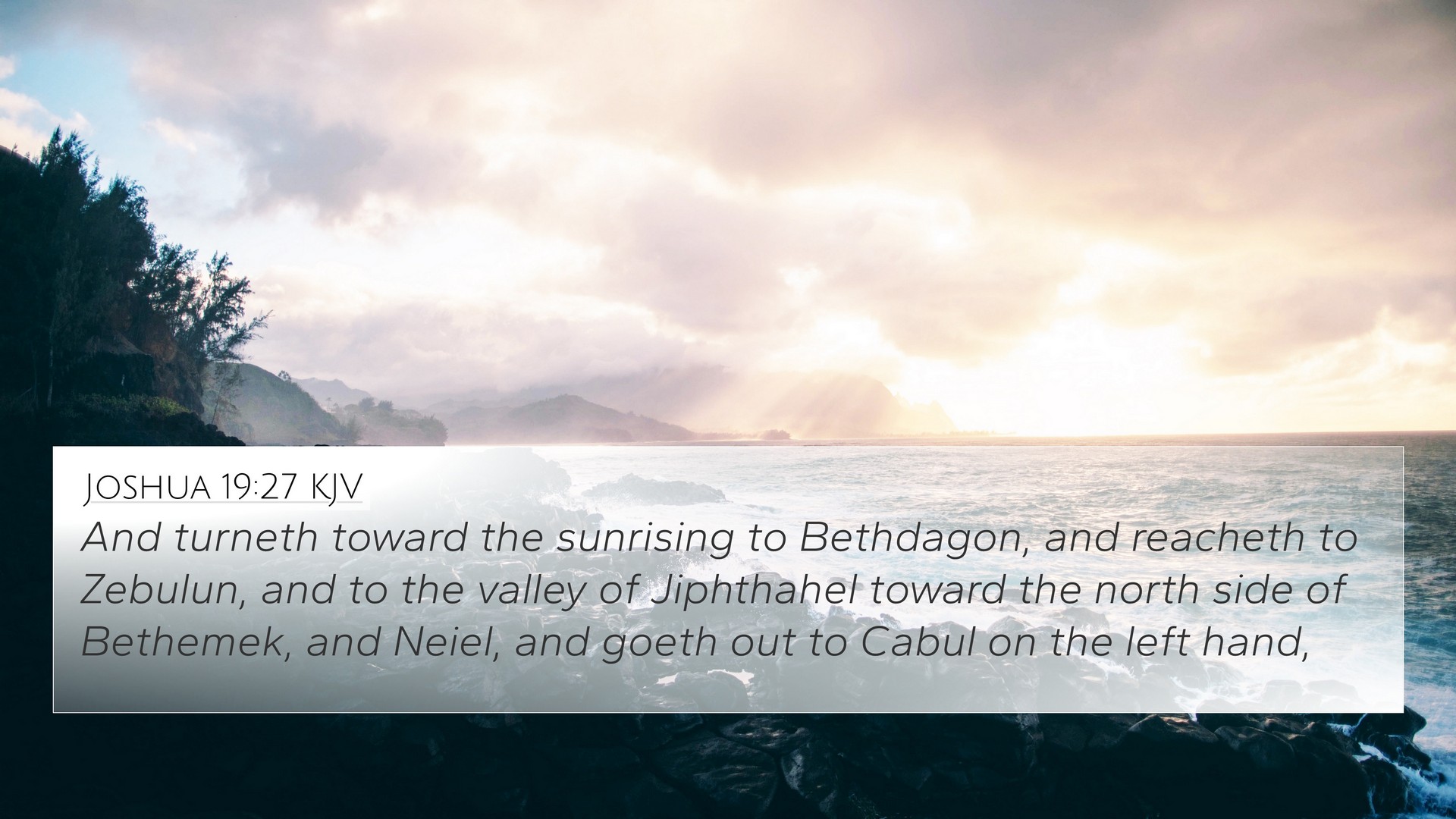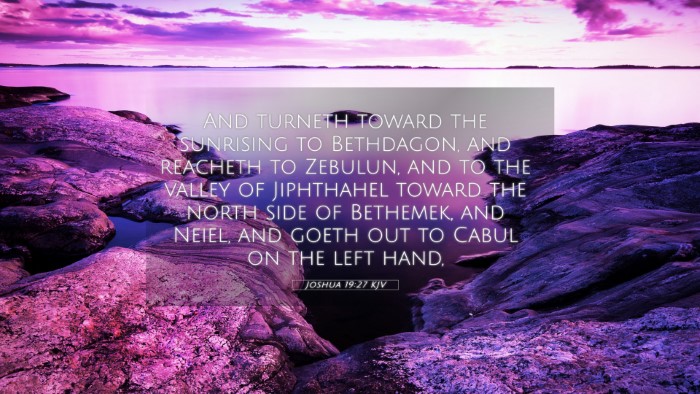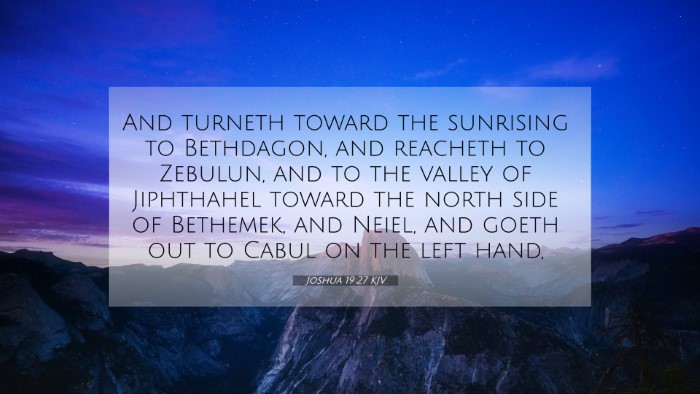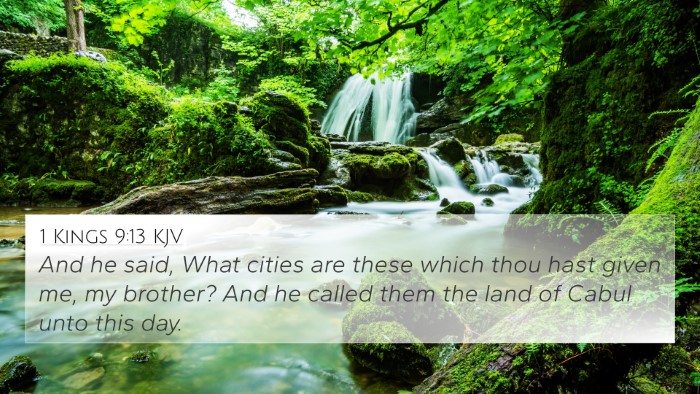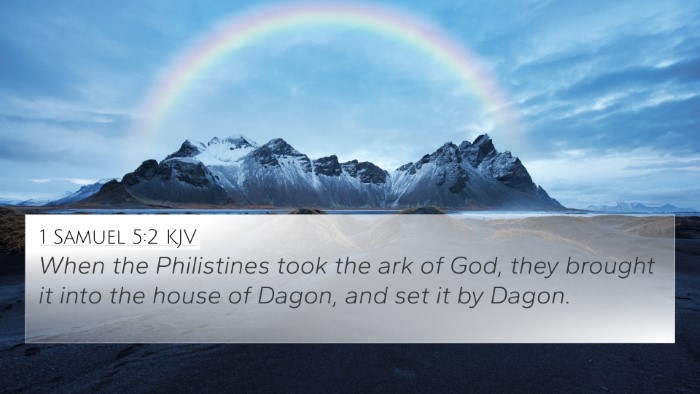Understanding Joshua 19:27
Verse: "And turned toward the sunrising; and the border went up to the top of Beth-horon, and turned to Gezer: and the goings out thereof were at the sea." (Joshua 19:27)
Summary of the Verse
This verse describes the geographical boundaries of the tribe of Dan as they settle in Canaan. It outlines the specific locations that define the territory allocated to them, emphasizing the importance of land demarcation in the Israelite community. Through this, we see not only the physical inheritance but also the fulfillment of God's promise to His people.
Commentary Insights
Matthew Henry's Commentary
Henry emphasizes the significance of the borders mentioned in this verse, noting that the detailed description promotes an understanding of God's providence in providing for Israel. The mention of Gezer indicates the land's strategic importance, highlighting the continuous conflict and the efforts required to secure the inheritance.
Albert Barnes' Commentary
Barnes explains the geographical references, illuminating how they create a tangible connection for the Israelites. The boundary markers exemplify the organization necessary for the tribe's identity. He points out that the mention of Beth-horon and Gezer serves as historical touchpoints revealing the larger narrative of conquest and settlement.
Adam Clarke's Commentary
Clarke delves into the implications of these boundary descriptions. He suggests that these locations not only serve as territory markers but also represent spiritual domains that will require vigilant stewardship by the Israelites. The specified borders connect to broader themes of divine promise and territorial integrity.
Bible Verse Cross-References
- Joshua 15:10 - Describes the border of the tribe of Judah, creating a contrast with Dan's territory.
- Jeremiah 47:2 - Highlights the geographical scope in the context of prophecy, showing the ongoing nature of these locations in Israel's story.
- 1 Chronicles 4:24-27 - Mentions the descendants of Judah and their land, offering insight into lineage and land inheritance.
- Matthew 2:23 - References the fulfillment of prophecy concerning dwelling in Nazareth, paralleling the significance of land in God's redemptive history.
- Luke 1:39-40 - Connects to the geographical theme, mentioning the hill country of Judah, thereby linking the New Testament to Joshua's depiction of the promised land.
- Hebrews 11:9 - Speaks of the faith of Abraham in looking forward to a promised land, linking to the territorial inheritance of the tribes of Israel.
- Exodus 23:31 - Discusses the boundaries of Israel, showing the continuity of God's promise in the land allocation.
Thematic Connections
This verse serves as an example of how the distribution of land among the tribes' encapsulates broader themes in Scripture, such as:
- Land as Divine Inheritance: Reflects God's promise to Abraham and his descendants.
- Tribal Identity: Establishes a sense of belonging and responsibility among the Israelites.
- Strategic Warfare: The borders outlined coincide with locations of future battles and possess a military significance.
- Fulfillment of Prophecy: Each territorial delineation points back to God’s promises reiterated throughout the Scriptures.
Tools for Bible Cross-Referencing
For those looking to dive deeper into the connections within biblical texts, various tools provide valuable resources:
- Bible Concordance: A comprehensive index of words used in the Bible, enabling one to find verses and their connections.
- Bible Cross-Reference Guide: A reference system that points out related verses and enhances understanding.
- Cross-Reference Bible Study: Methods to explore themes and topics by examining related scriptures.
- Bible Chain References: Links scripture passages that build on each other thematically and contextually.
Inter-Biblical Dialogue
The connections between Old and New Testament passages reinforce the integrity of Scripture. When studying Joshua 19:27, one can observe:
- Identifying connections: The legacy of land continues throughout the Bible, bridging both testaments.
- Comparative Studies: Analyzing different books can highlight thematic elements present in both covenant communities.
- Linking Biblical themes: Themes of inheritance, faith, and promise can be tracked from Genesis to Revelation, showcasing God’s consistent plan.
Conclusion
Joshua 19:27 is not merely a record of geographical boundaries; it encapsulates God's promise, the identity of His people, and the history of their inheritance. By using tools for cross-referencing and an understanding of thematic connections, one can better comprehend the spiritual and practical implications of this verse. Engaging with the text through such methods fosters a deeper connection with Scripture and enriches one’s faith journey.
